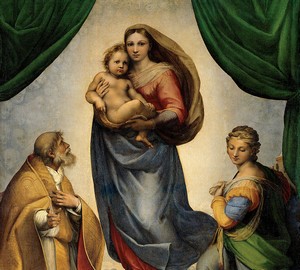
Description of the picture:
Sistine Madonna – Rafael Santi. Canvas, oil. 256×196
For several centuries, this particular work of the great master of the Renaissance has been adopted as the model and top of the old picturesque European school. The impeccability and depth of the work was recognized by critics, and no attempt to doubt the perfection of this canvas has been crowned with success, causing a storm of protests and the rejection of any critical analysis.
About the phenomenon ""public admiration"", which prevents us from perceiving this work individually and objectively, back in the 19th century, Tolstoy, Dostoevsky, and many artists spoke. Moreover, all as one agreed that this is an undoubted masterpiece.
The unusualness of this master’s work, for which the Mother of God with a baby in her arms is a favorite plot, is that she is painted on canvas. At that time, the vast majority of works of this kind were written on the boards. Some researchers believe that the artist chose the canvas because he could not find a board of the right size.
The painting was commissioned by Cardinal de Rover, future Pope Julius II. The work was intended for the altar of one of the provincial cathedrals, which kept the relics of St. Sixtus and St. Barbara. Both persons are represented in the picture next to the Virgin and the baby.
All the characters in the picture had prototypes in life. It is known that the artist wrote Pope Sixtus from the cardinal-customer. One of the legends of the picture claims that the pope is depicted as six-fingered. The failure of this statement is obvious if you look at the pope’s hand more closely.
The composition of the picture becomes clearer if you know that a crucifix should have been placed before work. Then the gesture of the pope becomes clear, indicating the Great Sacrifice of the Son of the Virgin in the future, as well as the mournful humility of St. Barbara.
An unusually lyrical sounding to the picture is given by a couple of angels at the very bottom of the composition. This sweet couple deprives the picture of any pathos, highlighting the main and simple sense of the plot – the mother’s anxiety about the fate of her son.
A strong impression is made by the non-childish face of the savior and his apparent outward resemblance to the Mother.
The viewer is deliberately baffled ""terrestrial"" a curtain strung on a primitive cornice. The thoroughness with which this obscure detail was written out confuses the public, makes them think about the meaning of this detail, its purpose.
The clouds of the background of the work, which are numerous angelic faces, emphasize the solemnity, significance of what is happening, bring to the work that sacred parade, which is an indispensable component of all the altar paintings of the Renaissance."